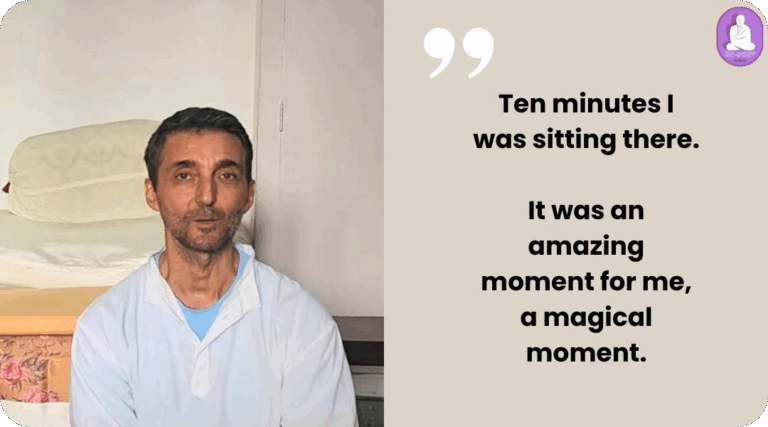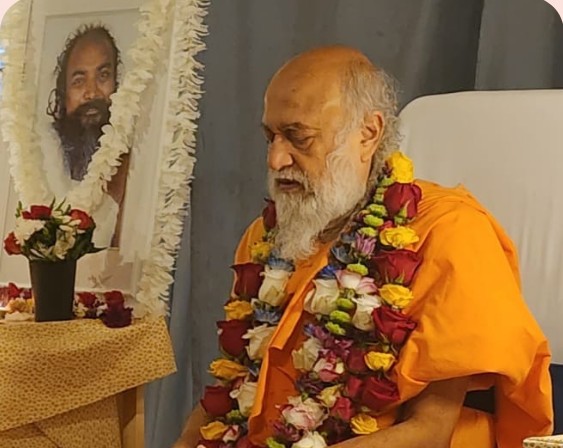London – 19th October 2013 – Part One

Offering my prostrations with deep love and reverence at the Lotus Feet of my Master Shivabalayogi, I greet you all this evening with my love and blessings. All of you have taken out your precious time to be here, to learn about the meditation we teach and to practice. I hope you will feel inspired to undertake this practice and achieve the things to yourself.
It all started in 1949 when the manifestation of the Divine as a Jangama Sage initiated my Guru at the age of fourteen into this technique of meditation and inspired, blessed, encouraged Him to do it for twelve long years. He was never trained into spirituality; nobody had told Him anything about meditation, spiritual truths or need of them. He had not met any other Saint or Yogis. He was born into a weaver’s family and was just trying to overcome the poverty. But He had certain inborn qualities − determination, sincerity. Once a task is given within moments He would accept the challenge and go for that. He believed in the ‘do or die’ type of determination, “I have to achieve” meaning only death can stop that effort. These qualities saw Him through the twelve years of Tapas.
Many of you might be trying to do different types of meditations. I have heard so many types of meditations are taught by different teachers from time to time. In this meditation silently you are asked to watch in-between eyebrows. He did that for twelve years. He used to say, “If we can keep the mind totally quiet hundred percent thoughtlessness into its pure consciousness state at least for one hour, that is the real meditation, means then you are able to meditate. And when one is able to keep it like that for eight to ten hours in a single stretch at least of that time, one is able to do the Tapas.” − that which He did for twelve years and attained Self Realization. When this is achieved one experiences the existence of one’s own Self as that Immortal Soul, ‘being there’ into the thoughtlessness state.
“What’s going to happen to humanity?”
Because the mind is used to sound and sight it is constantly spinning into its own thought effects, that which we call as imaginations. Mind imagines and spreads into thousands and millions of thought processes. These things get converted into cravings very often and gives unhappiness, tension and fear to humanity; conflict, mistrust, insecurity. These things today have given so much of conflict amongst humanity. Though almost everybody would like to have peace and happiness, the problem often is that though every one of us would like to have peace and happiness we would like to have it only for ourselves, we don’t want to bother for others also in this world. “If I want to be happy other also in this world would like to be happy.” We should try to facilitate that with consideration to others. It would be possible; when we try to live happily we don’t have to trouble others. We need to be sensitive to others’ peace and happiness. We simply don’t have to bother that, “If I am happy that’s enough, anything else can happen to the world.” This is the basic attitude of humanity that which we have come across today which has led almost the entire humanity into conflict, unhappiness, tension, fear and mistrust amongst themselves. Because this is the question very often asked to me, “What’s going to happen to humanity? When will the wars stop? When will this conflict stop?” We need to stop. It is we who are into conflict. We need to work for peace.
Everybody needs to understand that it is our mind which induces one into going into an insecurity. Because very often I have seen people listening to me for one hour everyday and after that talk if they don’t undertake the practice with the right technology that we try to tell every day they behave in a very egotistic, selfish way. They don’t want to consider anybody else’s needs, their peace or their security. That’s why I thought we have forgotten the spiritual truths, the spiritual techniques in the process of getting so much advanced through science, technology. We have achieved so many modern, amazing discoveries and inventions. We are able to get many things at the touch of a button. Perhaps only one such thing which has been elusive is the peace, which does not come through any machine, which does not come through money, which does not come through power or status. It needs to be achieved through a practice of spiritual sadhana.

That’s why I tell we have forgotten to grow spiritually. If we learn to grow spiritually then it’s no problem, we can enjoy everything that we have got into. The nature already had provided so many resources for us and we have tried to tap such amazing energies, we have come across discoveries and inventions, all such things we all can enjoy. It would be possible but provided that we have peace to ourselves. I hope you will all agree this is the priority most important today for humanity − wanting of peace and happiness which we very often forget but still we are looking for that only. Only the thing is that if we do not know the path we end up losing more peace, we end up getting into more conflicts, tension and fear.
“Even if a hundred or a
hundred thousand Yogis
come there is no conflict for us.”
See, I am a Yogi. Even if a hundred or a hundred thousand Yogis come there is no conflict for us. They all can be working trying to teach the methods of peace and these meditations, sadhanas. It may vary, the methods may vary, one might teach this type another might teach another type. There is really no conflict as long as the technique of the meditation is understood, as long as the purpose of such a sadhana is understood. Well it is natural for every Teacher like me to recommend the sadhana that we performed and we want to teach. However if it is a high-reached Yogi He will understand that every sadhana can lead you to the same truth of spiritual growth, achieving focus and concentration of the mind, total awareness of the Self.
My Master recommended this because you are looking to achieve things for yourself, that peace and happiness. Everything you want to achieve is for yourself. Even when you want to do some charity you want to achieve some happiness for yourself. So first try to know your Self, who you are, how you exist, in what way. That is what is important. So once you know yourself you will know what you need what you don’t need. Otherwise if we don’t know ourselves, if we are thinking something else as us and we are going after the things which we really are not, so we end up into more conflicts and more unhappiness. So that is why.
“If you are practicing
any other sadhana
– no conflict”
This meditation was obtained by my Guru by the manifestation of the Divine as a Jangama Sage, as I told. He practiced and He taught this meditation for thirty-three years when He travelled around the countries of India, Europe and America, Sri Lanka and so on. He taught in a very unique way, He said, “If you are practicing any other sadhana – no conflict.” He didn’t say, “Ki, you have to meditate only this and you should not be doing.” He was such a unique Teacher. If you have been initiated by any other Master also it is no conflict. In the midst of all such sadhanas you try to do this meditation also. In this silently when you are trying to watch in-between eyebrows, that watching is what is important in meditation. That is when the mind can become totally concentrated, focused and eventually silent. As long as the mind is not silent, when it is into its own imaginations constantly it is visualizing and thought processes are coming, coming, so the mind is not in silence. And if it is not in silence it has no peace also. Those thoughts constantly generate a brooding of the past and anxiousness about the future. That’s what these thoughts get converted into for everyone and it gives unhappiness.
So to silence this, ‘Watch’ is important. Because mind has a tendency with a technology to recognize an existence whether in its own imagination or it comes across like any other object of this world, and it analyzes either trying to listen to somebody else’s recommendation or on its own – “What is this? Is this good or bad? Will I be able to have it or not? Should I have it or not? Is this mine or not? Can this give happiness, power or any such thing that I am looking for?” These types of thoughts get generated. This is the analyzation effect of the mind and in this process somewhere it goes into a judgment. Somebody tells, “This is very bad” and it sits into my mind, “This is bad.” This becomes ‘bad’ because it is my mind, my mind tells with its own imagination that this is ‘bad.’ So that is why it is bad. Seldom I will apply my wisdom, “How do I know whether this is good or bad? I really don’t know. Somebody has told, that’s why my mind is also telling.” That is how the great Sages visualized the mind’s effects as simple imaginations that are generated which need not be the Truth of existence. “There must be something else.” They also understood the difference between the mind remaining as a consciousness and mind becoming a mind.
“What is this
pure consciousness?”
A mind is a mind due to the thought processes that are there. Like we can tell from the worldly point of view mind is a bundle of thoughts. If the same thoughts and visions everything gets cleared, the same mind is pure consciousness. What is this pure consciousness? Anywhere you apply your consciousness you can become aware of that existence. But when you apply your consciousness to the objects of this world externally, extrovert, it also gets involved into an imagination because it wants to know through intelligence what it is, whether it is good or bad, whether it is right or wrong, these are all the tendencies of the mind. So if this same consciousness is left to itself, means if this mind turns introvert, then that mind becomes aware of itself. That pure consciousness can become aware of itself, the existence in pure consciousness form, in the supreme peaceful state. That’s what one can achieve when we practice this meditation.































